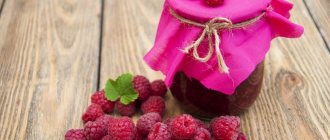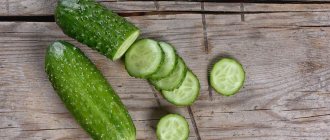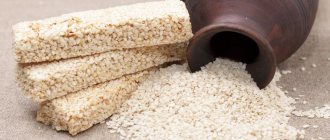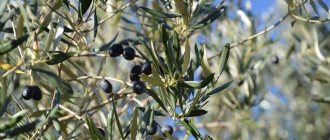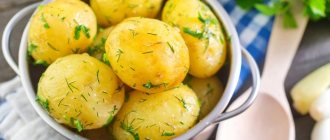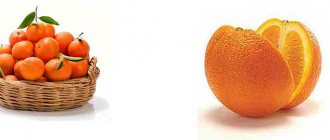Product calorie analysis
Ratio of proteins, fats and carbohydrates:
- home
- Product composition
- Composition of fruits and berries
- Chemical composition of “Raspberry jam”
Raspberry jam calorie content 273 kcal, chemical composition, nutritional value, vitamins, minerals, benefits Raspberry jam, calories, nutrients, beneficial properties Raspberry jam
Energy value, or calorie content
- this is the amount of energy released in the human body from food during the digestion process. The energy value of the product is measured in kilocalories (kcal) or kilojoules (kJ) per 100 grams. product. The kilocalorie used to measure the energy value of food is also called a food calorie, so when caloric content is reported in (kilo)calories, the prefix kilo is often omitted. You can see detailed energy value tables for Russian products here.
— content of carbohydrates, fats and proteins in the product.
Nutritional value of food product
- a set of properties of a food product, in the presence of which the physiological needs of a person for the necessary substances and energy are satisfied.
, organic substances required in small quantities in the diet of both humans and most vertebrates. Vitamin synthesis is usually carried out by plants, not animals. A person's daily requirement for vitamins is only a few milligrams or micrograms. Unlike inorganic substances, vitamins are destroyed by strong heat. Many vitamins are unstable and are “lost” during cooking or food processing.
Calorie content of honey
According to popular belief, all sweet foods, including honey, are very high in calories and are contraindicated for anyone watching their figure or following a strict diet. This is partly true, because one hundred grams of this product contains quite a lot of calories, so it is often used as a natural and healthy replacement for sugar.
But is it worth excluding natural nectar from your diet if you are strictly watching your figure? We will try to answer this question, as well as find out what the calorie content and nutritional value of honey is in this article.
Composition and beneficial properties of honey
Liquid or candied flower honey contains a lot of carbohydrates and natural sugar: fructose, sucrose, glucose, etc. These substances make up 80% of the total product.
But, in addition to these substances, natural nectar should contain:
- Nitrogenous substances that come not only from plants and flowers, but also from the bees themselves. The least amount of nitrogenous substances is in honeydew (about 1.5%), and the most in flower (almost 4%).
- Essential minerals that make this beekeeping product so useful and explain its widespread use in folk medicine.
- Vitamins are also present in natural honey, because bees produce it only from flower pollen, which contains many useful substances.
In addition, the product contains lipids, aromatic components and coloring pigments in small quantities.
Note: In its composition, honey is in many ways similar to human blood plasma, but its calorie content may vary depending on the variety. For example, light linden or flower nectar is considered the most dietary, and the maximum calorie content is observed in dark varieties.
It is impossible to deny the beneficial properties of nectar, because it is officially recognized as beneficial for the body as a whole and strengthening the immune system, especially during periods of exacerbation of colds (Figure 1).
This beekeeping product is truly capable of having beneficial effects on the body:
- Strengthens the immune system, effectively resists viruses and colds.
- The enzymes and amino acids included in its composition significantly improve the functioning of the digestive tract and help normalize appetite.
- Minerals and vitamins help quickly relieve inflammation, and natural fructose and glucose have a tonic effect on the body.
- In folk medicine, natural nectar is used as a remedy for the treatment of stomatitis, rhinitis, pneumonia and thrush.
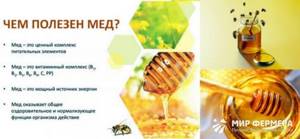
As a prophylactic agent, natural nectar can be taken to prevent sclerosis or restore the body after severe diseases of the internal organs. However, do not forget that this product is quite high in calories and can cause allergies, so before starting treatment, you must check the calorie content of this product and consult with your doctor.
Composition and ratio of BJU
Information about its energy value will help to accurately determine the calorie content of natural bee honey. This is an indicator that reflects the amount of energy entering the body when consuming certain foods.
Note: The energy value of this beekeeping product per 100 grams is 1272 kJ. If we talk about how many calories are contained in nectar for every 100 grams, then this figure will be 304 kcal.
We can conclude that the calorie content of the bee product is quite high, and in terms of this indicator it is even ahead of such nutritious products as beef, pork, milk or chicken eggs. For this reason, it is recommended to be consumed before intense physical activity or during rehabilitation therapy after injury, surgery or serious illness (Figure 2).
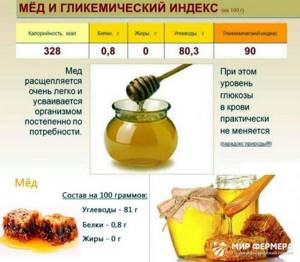
Calorie content of jam
Jam is a dessert obtained by boiling any fruit or berries (sometimes vegetables) with maximum preservation of the integrity of the product’s form. Sugar in making jam is used as a preservative for long-term storage.
How many calories in jam depends on the recipe according to which it is prepared, and more specifically, on the amount of sugar per kilogram of the original product, on the carbohydrate content in the product itself, the heat treatment time, the thickness of the syrup and the amount of water in it. The average calorie content of jam is 245-285 kcal/100 g, but if you use fructose instead of sugar, then the calorie content of jam will be significantly less - 150-155 kcal/100 g.
Despite the calories, it is preferable to use jam as a dessert, since it is a completely natural product that retains to varying degrees the biological value of the fruits and berries used in its preparation. For example, jam made from black and red currants, sea buckthorn, and apples almost completely retains vitamins. Like any product high in calories, jam should be consumed in moderation, but if possible, it is better to replace store-bought sweets on the menu with a few spoons of healthy and tasty jam for tea.
You can reduce the calorie content of jam if you prepare it from fruits and berries with minimal calorie content, such as rowan, sea buckthorn, barberry, cherry and the like, and replace sugar with honey, fructose or stevia.
Plum jam. Delicious plum jam for the winter
Jam according to this recipe can be made from any plums, but it is best from slightly unripe Hungarian plums. It makes an excellent and very tasty jam. Its thickness can be adjusted by the amount of sugar and the duration of cooking.
- plums – 2.5 kg (weight with pits)
- sugar – about 1 kg.
Jam yield: 4 jars with a capacity of 0.5 l.
Wash the fruits, remove the seeds and place them in a bowl with the inside facing up, sprinkling each layer with sugar.
It is better to take ripe or unripe fruits; they contain more pectin than overripe ones, which means the jam will be thicker.
According to the norm, sugar is added 1:1, but you can add much less sugar depending on the type of plum and your taste.
Leave them for several hours until the juice appears.
Stir, place over high heat, and bring to a boil. Then reduce the heat and continue cooking over low heat for 5 to 30 minutes (depending on the amount of juice and thickness acceptable to you).
When cooking, be sure to remove the foam. Taste and add sugar if necessary.
We suggest you read: When to pick oyster mushrooms
There is no need to remove the foam if you add 5 grams. butter for this amount of plums. Try it, this technique works!
Let cool slightly and blend with a blender until smooth jelly mass.
If you don’t have a blender, you can rub the boiled plums through a sieve (colander) and then add sugar. Or, in their raw form, try passing them through a meat grinder and adding sugar to the pulp.
This is what it should look like after grinding.
Attention, to get the mass as in the photo, the plums were cooked for 20 minutes.
After this, boil the jam further, stirring constantly, for 15-20 minutes once or twice depending on its thickness.
Cook over low heat to avoid burning.
Pour hot into sterile jars and close with sterile lids.
Jam for weight loss
Eating high-calorie jam while on a diet is not recommended, but you can reduce the energy value by reducing added sugar and including spices. It is good to include ginger with orange peels in dessert. Such supplements speed up metabolism, break down fats, and relieve cravings for sweets. You can cook it only from ginger root with lemon juice - the delicacy has a unique taste:
- To prepare you will need 150 grams of ginger root, two large oranges, lemon, a glass of sugar, 75 ml of water.
- The root is cut into cubes, filled with water, and the orange peels are soaked for three days.
- The ingredients are crushed, mixed with the juice of half a lemon, and cooked for five minutes.
- The finished treat is stored in the refrigerator in sterile jars with lids.
Pumpkin with oranges
Pumpkin jam is useful for weight loss, because the components in its composition normalize metabolism. The cooking proportions are as follows: for three kilograms of pumpkin pulp without peel and seeds, two large oranges, lemon, a little sugar. Peculiarities:
- Vegetables and citrus fruits are cut into cubes, covered with granulated sugar, and boiled for 10 minutes after boiling.
- The mixture is infused for three hours, boiled for 15 minutes, and placed in sterile jars.
- There are 25 kcal per 100 grams.
Raspberry
The properties of raspberry jam are said to be beneficial not only for weight loss, but also for the general condition of the body. The delicacy strengthens the immune system, protects against colds, and “kills” harmful bacteria. Nutritionists recommend eating no more than 2.5 teaspoons of the product per day, which contains about 10 g of sugar. This amount will not harm your figure and will not allow calories to be deposited.
Experts advise eating mashed berries with sugar or fructose, and if you cook them, the heat treatment should not take longer than 10-15 minutes to preserve the benefits. Raspberries have a positive effect on digestion - the seeds improve intestinal motility, normalize the production of gastric juice, help increase the feeling of satiety, and prevent hunger for longer.
Currant
Currant jam is considered one of the most useful for weight loss. It is better to process it for a short time in order to preserve the maximum amount of vitamin C. Unlike other types, it is better to cook blackcurrant jam rather than grind fresh berries. Currants refine sugar, which under its influence loses some of its harmful properties. It’s easier to cook for five minutes:
- For a kilogram of berries, take one and a half kilograms of sugar, one and a half glasses of water.
- Boil syrup, add berries to it.
- After five minutes of cooking, the dessert is ready.
Apricot
Apricot jam is tasty and healthy for weight loss, which can be eaten to supply the body with vitamins A, B, C, potassium, magnesium, phosphorus, iodine, iron and calcium. The delicacy retains substances even after heat treatment, improves digestion, blood circulation, and restores hemoglobin. Carotene has a positive effect on vision, metabolism and brain function, and removes excess fluid.
Tea with strawberry jam. 6 secrets to perfect strawberry jam
- Select the strawberries carefully and remove any spoiled ones. If you want to make jam with whole berries, choose beautiful, dense and not overripe fruits. Not too beautiful, bruised berries are suitable for jam with a uniform consistency.
- You need to wash strawberries very carefully, as they can become wrinkled and become too soft. Some advise not to wash at all, but simply wipe each berry with a damp towel. If the strawberries are too dirty, place them in a container of water and periodically stir them gently with your hands. After 15–20 minutes, sand and dirt will settle to the bottom. After washing, transfer the strawberries to a paper towel to dry.
- The stalks should be removed only from dry and clean berries. Otherwise, the strawberries will lose some of their juice, and the jam will not be so juicy and tasty.
- To diversify the taste of the jam, you can add spices to it, such as cinnamon, vanilla or cardamom, as well as aromatic herbs, such as mint or basil. You can add them at the end or at the beginning of cooking. In the second case, the aroma of spices and herbs will be more pronounced.
- Prepare jam in stainless steel or copper containers. An enamel container is also suitable, but provided that there are no chips on it. You can use aluminum cookware, but only if the jam is cooked in one step and immediately transferred to another container. If it is cooked in several batches and cools in the same container in which it was cooked, aluminum will not work. It can oxidize and ruin the taste of the jam.
- Skim off the foam during cooking. If you leave it, the finished jam will be stored less. In addition, without foam it will turn out more transparent, tasty and aromatic.
How many calories are in jam
Calorie content of jam made with the same amount of sugar from different berries and fruits per 100 g:
- Cherries – 230 kcal;
- Chokeberry – 246 kcal;
- Peaches – 248 kcal;
- Apples – 254 kcal;
- Quinces – 263 kcal;
- Strawberries – 264 kcal;
- Apricots, black currants – 265 kcal;
- Pears, strawberries – 271 kcal;
- Raspberries – 275 kcal;
- Plums – 281 kcal.
In the autumn-winter period, jam is an excellent source of vitamins, minerals, fiber, and mineral salts, which are preserved quite well in the product even after heat treatment.
Vitamins
Of the fat-soluble vitamins, apple jam contains A, beta-carotene, E and K. Of the water-soluble vitamins, there are vitamins C, B1, B2, B3 (PP), B4, B5 and B6.
>»> >»> >»> >»> >»> >»> >»> >»> >»> >»> >»> >»> >»> >»> >»> >»> >»>
| Vitamins, content | Share of daily value per 100 g | |
| Vitamin A | 3.0 mcg | 0,3% |
| Beta carotene | 24.0 mcg | 0,5% |
| Alpha carotene | 0.0 µg | 0,0% |
| Vitamin D | 0.0 µg | 0,0% |
| Vitamin D2 | n/a | 0,0% |
| Vitamin D3 | n/a | 0,0% |
| Vitamin E | 0.2 mg | 1,4% |
| Vitamin K | 0.6 mcg | 0,5% |
| Vitamin C | 0.2 mg | 0,2% |
| Vitamin B1 | 0.0 mg | 0,8% |
| Vitamin B2 | 0.0 mg | 0,8% |
| Vitamin B3 | 0.1 mg | 0,5% |
| Vitamin B4 | 3.2 mg | 0,6% |
| Vitamin B5 | 0.0 mg | 0,6% |
| Vitamin B6 | 0.0 mg | 3,4% |
| Vitamin B9 | 0.0 µg | 0,0% |
| Vitamin B12 | 0.0 µg | 0,0% |
Strawberry jam: calories and benefits
Strawberries contain a large amount of vitamins. So, 100 grams of these berries contain more than the daily norm of vitamin C. Strawberries also help strengthen the walls of blood vessels and the immune system
. Strawberry jam also contains:
- magnesium;
- iron;
- calcium and much more.
The calorie content of this product can vary and depends on how much sugar you put in it. Sugar also affects the amount of carbohydrates. On average, the calorie content of strawberry jam is about 284 kcal.
Canned strawberries are allowed to be consumed within reasonable limits even during diets.
Types of brew and approximate amount of calories in it
This product has a large number of varieties
. The most popular are:
- raspberry;
- cherry;
- strawberry;
- apple and others.
Vegetable jams are also made, but they are very rare.
The number of calories is affected not only by the composition of the product, but also by auxiliary components, in particular sugar.
Canned food contains a large number of useful substances, which are much more important than its calorie content, many of them have medicinal properties, are rich in microelements and vitamins
. They are often offered to patients with colds, coughs and high temperatures.
The calorie content of any brew is very high. On average, this figure ranges from 200 to 400 kcal per 100 grams of product and also depends on the sugar and the method of preparing the product. If it is made on the basis of fructose, then the number of calories will be lower, approximately 152 kcal per 100 grams. Do not overuse this product to prevent obesity. Even with a diet, a couple of spoons of delicacy will not pose a serious danger to your figure, but you will saturate your body with useful substances.
Calorie content of five-minute jam
If sterilization is used for long-term storage of jam, then the heat treatment process can be minimized to maximize the preservation of biologically valuable nutrients. The five-minute jam recipe requires half as much sugar as regular jam, which means the number of calories in the jam will be almost half as much.
Berries or fruits are sprinkled with sugar, infused, releasing juice, or hard berries and fruits with thick skins are filled with sugar syrup. After some time, the syrup or released juice is drained, brought to a boil and fruits or berries are immersed in it for 5 minutes of boiling. The jam is packaged in sterile containers and hermetically sealed; it should be stored in a dry and cool place.
It is especially recommended to prepare raspberry, sea buckthorn, viburnum, rowan and currant jam according to this recipe - an excellent source of vitamins for the winter, often used for the prevention and treatment of colds. The lower the calorie content of the jam that is used for treatment, the less the burden on the unhealthy body and the higher the therapeutic value of the product.
Despite the calorie content, jam is a wonderful dessert and a wonderful homemade natural doctor. Jam should be prepared for future use in quantities that satisfy the needs of the family during the winter. Candied jam that has been stored for a long time, apart from an excess of sugar, no longer has any other nutritional value. You should also use jam wisely. A few spoons a day will not add extra pounds, but will provide the body with useful and necessary nutrients.
How to make plum jam?
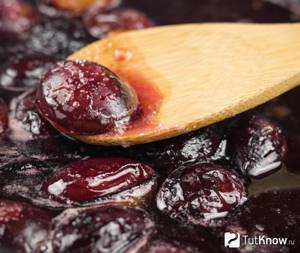
There are a huge number of recipes for plum jam. This method of preparation is considered classic: the fruits are covered with sugar in equal proportions - for 1 kg of plums you will need 1 kg of sugar - and wait for the juice to form, and when a sufficient amount appears, the future dessert is put on the fire and boiled. This recipe for plum jam can be made with a pit, or you can remove the pits first; this process, of course, takes time, but the resulting dessert will be much more pleasant to eat.
As for the cooking time, it all depends on what consistency you want to get, for example, five-minute plum jam is prepared in just 5 minutes and immediately poured into jars; of course, it will not contain thick syrup, but it will retain more benefits. If you want to get thicker jam, you can cook it several times for 5 minutes, pre-cooling after each cooking, or you can cook it without cooling, but then you will need to cook it for 30-50 minutes straight.
There is, however, an interesting way that allows you to prepare delicious thick plum jam in 5 minutes: at the moment of boiling, a thickener is added to the dessert - pectin, agar or gelatin. It is worth noting that, of course, it will not thicken instantly, but you can safely pour the liquid jam into jars; as it cools, it will gain a good thickness.
If you have a lot of time on your hands, be sure to try making seedless plum jam. To prepare it, the fruits are first pitted, then whipped in a blender, mixed with sugar and boiled until the desired thickness is achieved, resulting in a wonderful jam.
To achieve maximum health benefits, you can make “live” jam from plums; it is prepared in the same way as jam: the fruits are pitted and beaten with sugar, but instead of boiling, the dessert is placed in plastic containers and put in the freezer.
You can experiment with plum jam by combining it with other berries and fruits. The best combinations are obtained with pears, apples, and apricots. It’s also interesting to get creative with “seasonings” - add vanillin, cinnamon, cloves, lemon zest to the jam, so it will not only be more original, but also healthier.
Finally, it is worth noting that if you cannot eat sugar for one reason or another or you generally avoid it in your diet, it is quite possible to make jam using a substitute, but it is advisable to choose natural sweeteners - honey, stevia, erythritol, xylitol, coconut sugar etc.
Apple jam: calorie content and composition
Jam made from apples has a calorie content of 265 kcal per 100 grams of product
. It contains the following components:
- vitamins of different groups;
- minerals;
- coarse fiber.
Unlike other jams, apple jam can be consumed even by those who are afraid of gaining extra pounds.
Most vitamins (groups A, I, P, PP, K) are preserved when the fruit is cooked, but vitamin C almost completely disappears, but it can be restored if you add rose hips to apple jam when cooking. The finished product also contains pectin
, which helps remove cholesterol from the body. It is known that apples themselves are a source of potassium and iron, and they are recommended to be consumed for cardiovascular diseases.
Apple jam is also very useful for colds, but it should be used with extreme caution by those who suffer from stomach ulcers or gastritis. If your acidity is high, then cook it from sweet varieties of apples, and if it is low, then you need to prepare sour varieties of fruit.
It is good because it retains most of the beneficial characteristics of the fruit on which it is prepared. And if it is “raw”, then it is the best source of vitamins during the cold season. This product is also a strong source of glucose.
. Different types have their own characteristic beneficial properties:
Whatever option you choose, and no matter how high in calories it is, remember that this product is healthier than cookies or chocolate
, and causes much less harm to the figure.
Raspberries are one of the most beloved and popular berries for many. We love it for its extraordinary aroma and, of course, for its benefits. In order to enjoy their favorite delicacy even in the winter season, many people prepare raspberry jam for future use. What is the caloric content of such a dessert, and whether it will have a detrimental effect on the figure - these are the questions that many people with a sweet tooth, especially women, love.
Calorie content of plum jam and its effect
For 100 grams of plum product there is:
- 288 kcal;
- 0.4 g proteins;
- 0.3 g fat;
- 74.2 g carbohydrates.
Preservation based on plums contains large amounts of vitamin P
or as it is also called, routine. This component of the product helps to improve a person’s blood pressure, helps improve the functioning of the endocrine system, and it also acts as a conductor of vitamin C, which helps strengthen our immune system.
Plum jam also has the following beneficial properties:
- helps improve the functioning of the gastrointestinal tract;
- the stomach begins to work better;
- The problem of constipation is solved due to the laxative effect of boiling. It is achieved thanks to the presence of plums, which themselves have such an effect.
In plum jam, the element potassium is fully preserved; it is useful because it has a diuretic effect and can free the body from excess fluid or salt. That is why this type of jam will be extremely useful for those who suffer from kidney ailments and edema.
The plum delicacy also contains the following useful ingredients:
- magnesium;
- phosphorus;
- iron.
They have a beneficial effect on metabolism, help with anemia, help improve memory and strengthen the skeletal system. Just a few spoons of sweetness - and you will get rid of stress and depression.
Plum jam also contains large amounts of vitamin E, which is responsible for beauty. It is a strong antioxidant that slows down the aging process of our cells. In addition, this vitamin has a good effect on blood circulation and prevents the formation of blood clots.
How many calories are in jam
Most (if not all) weight loss diets recommend limiting, first of all, the consumption of fats and sugars, and the ban mainly concerns sucrose, as the most harmful of simple carbohydrates. In this regard, we stop putting sugar in tea, eating sweets and confectionery, soda, candy, and giving up jam. And if the first listed restrictions are completely justified, then giving up jam is not so simple. On the one hand, the calorie content of jam is quite high, and the sucrose content in it is substantial. On the other hand, jam is made from natural fruits and berries and contains a lot of useful substances. And on the third hand, during a diet you really want to eat at least something sweet, allow yourself at least some dessert, otherwise it becomes completely sad - after all, even fruit can sooner or later get boring. So what to do? Should you exclude jam from your diet or not? And by the way, how many calories are in jam?
The main source of calories in jam is sucrose. As you know, jam is cooked with a lot of sugar. And the fruits themselves contain simple carbohydrates - fructose and glucose. The calorie content of jam is approximately the same as the calorie content of candy - one candy and one teaspoon of jam contain approximately the same number of calories.
You can find out how many calories are in jams made from different fruits from the jam calorie table.
Calorie content of jam per 100 g of product:
- pear jam – 214.6 kcal;
- apricot jam – 241 kcal;
- quince jam – 221.8 kcal;
- watermelon rind jam – 263 kcal;
- barberry jam – 203.7 kcal;
- lingonberry jam – 160.3 kcal;
- lingonberry-apple jam – 247.1 kcal;
- lingonberry jam with cinnamon and cloves – 243.7 kcal;
- pitted cherry jam – 219.4 kcal;
- honeysuckle jam – 218 kcal;
- blueberry and raspberry jam – 229.1 kcal;
- raisin jam – 295.9 kcal;
- citrus zest jam – 174.3 kcal;
- sea buckthorn jam – 164.6 kcal;
- raspberry jam – 275 kcal;
- plum jam – 281 kcal;
- strawberry jam – 271 kcal;
- tangerine jam – 278 kcal;
- blackcurrant jam – 263 kcal;
- apple jam – 254 kcal;
- peach jam – 248 kcal;
- strawberry jam – 274 kcal;
- chokeberry jam – 246 kcal;
- cranberry jam – 198 kcal.
As we can see, the calorie content of jam is quite considerable. However, you most likely will not eat jam in large quantities - you will simply add a couple of spoons to your tea or eat a few spoons of jam as a snack with tea.
One teaspoon contains about 15 g of jam. That is, if we conventionally take the calorie content of jam as 250 kcal per 100 g (average calorie content of jam), then 2 teaspoons of jam will contain 75 kcal. You can totally afford it.
Counting calories
Fresh raspberries have 46 kilocalories per 100 grams of product. Of course, after the berry turns into jam, the calorie content of the product increases significantly due to the addition of sugar.
100 grams of finished jam contains from 270 to 275 calories. Anyone who follows a healthy diet every day and monitors their diet understands that jam is a very high-calorie product. For example, a piece of any cake has almost the same calorie content as this aromatic delicacy of equal weight.
Therefore, in order to get maximum health benefits and avoid harm to your figure, we recommend monitoring the amount of jam you consume. Of course, if you eat a little of this product a day, you will get nothing but benefits. If it is just one teaspoon consumed with tea, then, as a rule, it is only 7-8 grams of jam, which means only 18-20 kilocalories.
By the way, when consuming this or that product, in particular jam, pay attention not only to the calorie content of the product, but also to the carbohydrate content, since they are the ones that harm our slimness. There are practically no proteins in this product, only 0.6 grams, and even less fat - 0.2 grams, but carbohydrates - 70.4 grams. If we look at everything in percentage terms, it turns out that proteins and fats together occupy less than 1%, and carbohydrates account for almost three-quarters of the total weight.
Is there any benefit to this jam?
Fresh and aromatic raspberries contain a large amount of vitamins and beneficial properties. It's no secret that this berry is rich in phytoncides, which is why it is rightfully considered one of the natural antibiotics. This berry, which many people grow in their gardens or collect in the forest, has an excellent antimicrobial effect, which makes it possible to use it for colds and more.
In addition, raspberries can strengthen the immune system and protect our body in every possible way from harmful external influences. But all these benefits apply to fresh berries. But is there any benefit left in jam?
Raspberries are a unique berry, one of the few that, even after cooking, retains all its beneficial properties and qualities as much as possible. That is why many people prepare raspberries for the winter, and they are an excellent remedy not only for colds during the cold season, but also help to quickly and effectively reduce the temperature during a viral illness.
How to reduce calories?
Many people, in order not to spoil the taste of raspberries with sugar or make jam or preserves, simply freeze the berries and enjoy eating them in the cold season. The option is undoubtedly excellent, but there is a small problem: not everyone in the house has large freezers that allow you to stock up on raspberries for future use. In this regard, jam is much more convenient, but many are confused by its sky-high calorie content, which is harmful to the figure. However, there is a real way that helps to significantly reduce the calorie content of the finished product.
If you cook stocks of aromatic dessert without using sugar, but replacing it with fructose, the calorie content of such a product will decrease to 152 calories for every hundred grams. It turns out that such jam will be more than a hundred kilocalories “lighter”, although there will not be much difference in taste. Agree, this is no longer so scary, and now you can even afford two spoons of your favorite delicacy.
Another option is to replace part of the granulated sugar with stevia powder. This powder, which is somewhat reminiscent of sugar, contains 0 calories. That is, if you replace half the amount of sugar, the calorie content of the finished product will be halved. There is no need to be afraid of stevia powder, as it is a natural product made from a plant of the same name. It only has beneficial properties.
- Do not cook more than two kilograms of berries at a time, even if you have large dishes. A small amount of berries will preserve their taste as much as possible, and the jam will be especially aromatic.
- You need to cook the dessert in several stages, since with prolonged cooking without breaks, the berries will lose their shape and give too much juice.
- In order to make so-called live jam, you don’t have to cook the berries - just grind them with sugar. For a kilogram of berries you will need eight hundred grams of sugar. Some of the sugar can be replaced with other ingredients that we discussed above. This product can only be stored in a cold place - a refrigerator or cellar.
- This berry goes well with many herbs, such as green basil, mint and even rosemary. These herbs will not only help improve the taste, but will also add benefits.
- Raspberries can be prepared for the winter by drying the berries. Afterwards you can make compote or jam from them.
Remember that the caloric content of dried berries per hundred grams is slightly higher than fresh ones - approximately 55-60 kilocalories.
You will learn more about the benefits of raspberry jam in the following video.
Since any diet excludes the consumption of confectionery and store-bought sweets, and the need for sweets in most cases remains, those losing weight resort to healthier sweet treats: honey, jam, dried fruits, nuts, natural desserts - marshmallows.
Of all the above, jam is the most popular.
The benefits of jam
Despite the high calorie content of jam, it is very healthy. Natural fruits and berries from which jam is made contain vitamins, fruit acids, and a large number of useful microelements. During heat treatment, some vitamins (in particular, vitamin C) are partially destroyed. Therefore, it is better to eat jam that has undergone minimal heat treatment (for example, currant jam, which is often not boiled at all, but simply ground with sugar and sealed in jars).
Heat treatment does not destroy B vitamins, fiber and minerals contained in the jam.
Jam is used for colds, weakness, and headaches; chokeberry jam lowers blood pressure, and sea buckthorn jam removes salts and toxins from the body.
The most common use of jam is for colds. Thanks to vitamins and high calorie content, jam has antipyretic and anti-inflammatory effects. Many jams made from sour varieties of berries retain a fairly large amount of vitamin C and can be used to prevent colds and strengthen the immune system, as well as to quickly restore strength after illness. Berry jam relieves sore throat and cough, warms and soothes. The B vitamins contained in berries help fight stress, depression (including the so-called “winter depression”), anxiety, improve sleep and stimulate brain function, improve memory and attention. Pectins contained in jam help eliminate toxins and heavy metal salts from the body.
Useful properties of plum jam
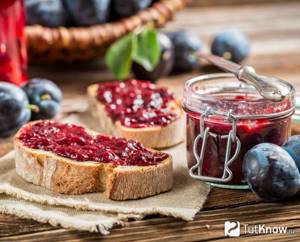
Thanks to its rich chemical composition, plum jam has a beneficial effect on the body. It has been proven to help with stool disorders. The fruit contains pectin and sorbitol, which have a pronounced laxative effect, and therefore by eating a small amount of dessert daily, you can get rid of chronic constipation. However, this is not the only benefit of plum jam. Let's take a closer look at its beneficial properties:
- Normalization of the cardiovascular system
. The product has a beneficial effect on the functioning of the heart and blood vessels, helps normalize blood pressure, and strengthens the walls of capillaries. In addition, it stabilizes blood cholesterol levels, prevents the development of thrombosis and acute cardiac conditions. - Strengthening the immune system
. The product has a stimulating effect on the body's defenses, and therefore during the cold season, plum jam can become not only a tasty addition to tea drinking, but also an assistant in the fight against viruses. The dessert has a complex - antipyretic, expectorant, diaphoretic - effect. - Acceleration of metabolism
. Plum jam has a positive effect on metabolism not only due to the presence of pectin, fiber and sorbitol, but also due to the presence of B vitamins. Thanks to this property, the dessert helps remove waste and toxins from the body, and helps to lose excess weight when consumed sensibly. - Diuretic effect
. The product has a mild diuretic effect, and therefore helps prevent diseases of the genitourinary system and helps avoid edema. The stimulating effect on the kidneys is another important step in protecting the body from the accumulation of toxins. - Prevention of vitamin deficiency
. Despite the fact that vitamins and minerals are not present in the dessert in record quantities, the overall rich and broad vitamin and mineral composition saves from the development of vitamin deficiencies, which often develop in the autumn-winter period. In particular, the product saves from anemia by replenishing iron reserves, and prevents osteoporosis by fighting bone fragility. - Antioxidant effect
. Due to the content of a large amount of antioxidants, plum jam helps fight excess levels of free radicals, which prevents early aging, due to which, in particular, the complexion improves and wrinkles are smoothed out. The antioxidant effect also provides cancer prevention. - Beneficial effect on the endocrine system
. Dessert also has a positive effect on the endocrine gland. This is especially important given the fact that thyroid diseases - in particular hypothyroidism - are very common today. - Toning effect
. The product has a positive effect on the nervous system. It tones, invigorates, lifts the mood, and with regular use helps fight memory disorders and insomnia.
As you can see, the dessert is really very healthy, and therefore it is simply necessary to close the jar of plum jam for the winter in order to protect yourself not only from colds and vitamin deficiencies, but also to comprehensively improve the health of the body.
What does raspberry jam help with?
Raspberry jam is used in folk medicine. It not only relieves symptoms, but also enhances the effect of medications. So, the berry helps with:
- Pancreatitis. Foci of inflammation may appear on the pancreas. Raspberry jam will help remove it. The berry contains substances that ensure tissue regeneration;
- Gastritis. Raspberries have an enveloping effect. With its help you can remove unpleasant symptoms such as flatulence, heartburn;
- Cholecystitis. The berry helps improve the flow of bile and prevent cholecystitis.
- Atherosclerosis. The composition is rich in vitamins, including A, C and E. Retinol, ascorbic acid and tocopherol strengthen the walls of blood vessels and reduce the risk of heart attack.
Anemia is something that raspberry jam also helps with. The treat contains magnesium, which is involved in the construction of new blood cells.
Raspberry jam is good for coughs. The berry contains phytoncides, or natural antibiotics. Therefore, candied berries have an antimicrobial effect. They also speed up metabolic processes, which is useful in the fight against dry cough.
Raspberries are especially valuable for those who suffer from ARVI. A hot drink with jam reduces cough and sore throat, lowers fever and improves immunity.
Features of various types of jam, calorie content
Sea buckthorn jam retains a lot of vitamin C and is a valuable source of potassium, which is necessary for muscle function and for removing excess salt and water from body tissues, as well as beta-carotene, which is converted into vitamin A in the body. Sea buckthorn is the undisputed leader in vitamin C content among berries, even black currant has less ascorbic acid than sea buckthorn. Therefore, a couple of spoons of sea buckthorn jam a day will help you strengthen your immune system and maintain health and vigor throughout the winter. In addition, sea buckthorn contains natural antibiotics - phytoncides, so at the first signs of illness, you can safely eat a few spoons of sea buckthorn jam - this will only bring benefits and give the body good support in the fight against the disease.
Cranberry jam successfully fights “bad” cholesterol and high blood pressure. Cranberry has a beneficial effect on the kidneys and removes excess fluid, salts and toxins from the body. Cranberry improves stomach function and prevents stomach ulcers; due to its high potassium content, cranberry jam strengthens the heart muscle. The calorie content of cranberry jam is 198 kcal per 100 g (30 kcal per teaspoon).
Chokeberry jam reduces blood pressure, which can be very useful for hypertensive patients. Chokeberry also helps relieve stress – both physical and mental. The calorie content of chokeberry jam is 246 kcal per 100 g.
Raspberry jam is the first aid for colds; it can be called natural aspirin. Raspberry jam also strengthens bones due to its high calcium content. The calorie content of raspberry jam is quite high - 275 kcal per 100 g, but for a cold, tea with raspberry jam is the first remedy.
Strawberry jam is high in antioxidants, so it preserves youth and prevents the formation of cancerous tumors. The calorie content of strawberry jam is 271 kcal per 100 g.
Blueberry jam contains many vitamins, iron and manganese and is an excellent preventative against anemia. Calorie content of blueberry jam is 214 kcal per 100 g.
The benefits of raspberry jam and possible harm
All the described substances are necessary for humans. They help with:
- Elevated temperature. Raspberries contain a lot of acetylsalicylic acid, which has an antipyretic effect.
To the question whether raspberry jam can be made at temperature, the answer will be positive. Many are afraid to consume it during hyperthermia, but their fears are in vain. Raspberries have the ability to thin the blood, thereby reducing the temperature and making the patient feel better. The natural product acts similar to Aspirin.
- Skin diseases. The berry contains vitamin C, which accelerates tissue regeneration.
- Thrombophlebitis. The substances in the composition thin the blood. Due to this, the risk of stroke is reduced;
- Poor vision. Anthocyanin glycoside and vitamin A relieve eye strain.
In addition, the berry neutralizes carcinogenic substances. Therefore, such jam is useful for people who eat fatty and unhealthy foods.
Raspberries also have an antimicrobial, astringent effect. It contains tannins that heal wounds. Therefore, the berry can be consumed not only as food, but also externally. It helps remove rashes and swelling.
Benefits for women
With the help of raspberries you can get rid of early wrinkles. Regular consumption of berries prevents their appearance.
It also slows down the aging process. This is explained by the fact that raspberries contain many useful substances involved in cellular metabolism.
It is recommended to eat jam and fresh berries during PMS. Thanks to magnesium and vitamin B2, raspberries improve blood flow, cope with nausea and relieve pain.
Benefits for men
Zinc and B vitamins are important for men's health. They not only improve your mood, but also ensure the production of testosterone.
Raspberry jam is recommended for those who engage in strenuous sports. Raspberries contain minerals necessary for the growth of bones and muscle tissue.
Raspberry jam during pregnancy
Pregnant women should eat raspberry jam with caution. It can cause allergies, especially in the last trimester and be harmful. With moderate consumption, the harmful properties of the product are neutralized, and the benefits increase.
Raspberries strengthen the immune system and normalize body temperature. It also helps eliminate toxins, which is important during pregnancy.
Raspberry jam has a high content of folic acid. This substance is necessary when planning pregnancy.
Raspberries alleviate toxicosis, improve peristalsis and remove swelling. However, salicylic acid contained in the berry can negatively affect the baby. It causes strong contractions of the uterus, which in the early stages leads to miscarriage. Therefore, you can eat jam or drink decoctions only on the recommendation of a doctor.
The benefits of jam during breastfeeding
The berry can only be consumed after the baby is one year old. At a younger age, the product will harm the baby: it will provoke food allergies.
A raspberry dessert will benefit your child if used in moderation. It ensures normal brain development and functioning.
Raspberries are essential for nursing mothers. During breastfeeding, a woman loses valuable vitamins, and the berry can replenish their supply.
For children
Raspberry jam is not prohibited for children. The main thing is to eat no more than one or two teaspoons a day so as not to harm the body.
Raspberries are essential for the development of the body. Thanks to it, muscle tissue grows and bones become stronger.
When losing weight
Fresh berries contain 46 kilocalories per 100 grams. But jam has a higher calorie content due to the sugar it contains. Its nutritional value is 270 kcal. It is harmful for those who are overweight.
Harm and contraindications
It is extremely undesirable to consume quince seed; it contains amygdalin, a substance that causes severe poisoning and can lead to a lack of oxygen, irritation of the mucous membranes and swelling of the larynx.
Quince fruits can negatively affect the vocal cords, weakening them, so it is contraindicated to use them before public speaking and for people who sing.
The fluff on the surface of the fetus can provoke an allergic reaction, throat irritation and coughing attacks. It is not recommended for use by people suffering from constipation, stomach ulcers and colitis. Unripe fruits can also cause serious harm to the stomach and intestines.
Girls, I'll kill him now.
| March 18, 2013 | 2403 | 5 |
| HTML code: | ||
| BB code for forums: |
How will it look like?
Diets.ru → Girls, I’ll kill him now.
| We sit in the kitchen and argue with the beloved: he believes that it is healthier (in terms of calories) to eat 3 teaspoons of apricot jam than 1 apple. I can’t find the calorie content of jam anywhere - the fact that almost 400 kcl in 100 grams of sugar does not convince him, because jam DOES NOT CONSISTE OF SUGAR ONLY, there are also APRICOTS in there! And damn it’s not breakable at all! Who can tell me information about jam, otherwise I might end up a widow Read more |
Diary of the Dream Keeper:
Sometimes people refuse a delicious bowl of jam when visiting, citing the fact that the calorie content of the jam is too high. In principle, these people are right, because jam is indeed a very high-calorie product. And it's all about sugar, of course.
It’s surprising that we are used to closing a large number of jars of jam for the winter, naturally without eating it during the winter. The longer it sits, the more it can become sugary. This only harms the jam. How do you feel about sweets? How many candies would you eat in one sitting: one, two, three? Please note that one teaspoon of jam has the same calories as one chocolate candy.
Depending on the type of jam, you can turn a blind eye to the calorie content, because its healing qualities at some point will turn out to be much more important than the calorie content.
Thus, raspberry, blueberry, rowan and viburnum jam are your home doctors who will come to the rescue and provide more effective help than tablets. It should be noted that after boiling, not all berries and fruits are able to retain vitamins. But apples, sea buckthorn, red and black currants retain vitamins fully.
The lowest calorie jam is cherry. Rowanberry is not inferior to it. There is also a lot of phosphorus in rowan. Barberry, sea buckthorn, walnut, hawthorn, dogwood are also not particularly high in calories in jam, because they have more medicinal properties. But you shouldn’t get carried away with such jam either, especially during illness. You need to know when to stop, because you don’t eat a pack of pills at once, do you? You shouldn’t empty the jar of jam right away, because you’ll only make it worse. The calorie content of jam multiplied by an empty jar is much higher than the calorie content multiplied by a full jar. This simple logical problem brings a smile only when the figure is not threatened by such calculations.
The most effective jam is raspberry jam. Despite this, its calorie content is high - 275 kcal. Raspberry jam, alas, is not ideal in terms of vitamins. After heat treatment, vitamin C is destroyed by almost 70-80%, which is why the jam gains a large percentage of calories. Some housewives know that it is more effective for medicinal purposes to use five-minute jam, which does not suffer so much from heat treatment and retains vitamin C almost intact. Raspberry jam also has a fairly good effect on the liver, neutralizing the negative effects of smoked and fried foods on the body.
Let's finally look at the table that shows the calorie content of jam:
boiled plum - 281 kcal; tangerine jam - 278 kcal; raspberry jam - 275 kcal; pear jam - 271 kcal; strawberry jam - 271 kcal; quince jam - 263 kcal; blackcurrant jam - 265 kcal; apricot jam - 265 kcal; apple jam - 254 kcal; peach jam - 248 kcal; cherry jam - 230 kcal; strawberry jam - 274 kcal; chokeberry jam - 246 kcal.
Thus, the calorie content of jam is a serious matter. Don't get carried away with this product. If your figure is important to you, try to consume jam in moderation. In addition, an abundance of sugar is also not good. But in winter, you can carve out a wonderful evening for yourself by filling a vase with your favorite jam and savoring it with aromatic tea.
Important to know about jam
It is clear that jam is a very high-calorie product, and the longer it sits, the more it becomes sugared. This harms the jam and increases its calorie content.
It should be noted that one teaspoon of jam contains the same calories as chocolate candy.
Sometimes it happens that the calorie content of jam is less important compared to the beneficial properties
. For example, everyone knows that raspberry is simply irreplaceable during a cold. Blueberry, rowan, and viburnum jam are also very useful. Almost everyone has them in their home medicine cabinet and are often more effective than medications.
After boiling, sea buckthorn, apples and currants - both red and black - retain their beneficial properties and vitamins, so jam made from them is also very useful.
But one of the lowest-calorie jams is cherry jam. Rowan is almost as good as it in this regard. Next come sea buckthorn, walnut, hawthorn, and dogwood.
Of course, this does not mean that you can immediately “sentence” a whole jar; after all, sugar does not go anywhere and makes up the high calorie content of jam, even the healthiest one.
By the way, the most effective is raspberry. However, it has a fairly high energy value: 275 kcal. In addition to helping with colds, it also has a good effect on the liver, neutralizing the negative effects of smoked and fried foods.
Unfortunately, after heat treatment, up to 80 percent of vitamin C is destroyed, so it is better to use five-minute jam or simply fresh raspberries grated with sugar.
How many grams of jam in a spoon (teaspoon, tablespoon)
Good afternoon, today we will tell you how many grams of jam are in a spoon. Jam is very often used in cooking to make sweets. It is added to baked goods, desserts, and flour and grain dishes. Therefore, you often need to know the weight of the jam in order to prepare a delicious dish according to the recipe. This information will also be useful for those who are watching their figure. By measuring the jam with a spoon (teaspoon or tablespoon), you can calculate the approximate amount of calories you are going to take. Of course, it is best to measure the jam with a kitchen scale. If you don't have a kitchen scale at home? You can measure the jam with a glass, a teaspoon and a tablespoon. See table below.
How many grams of jam in a spoon
| In one spoon of jam | Weight in grams | Calorie content of jam |
| In 1 teaspoon | 15 grams jam | 34.36 Kcal |
| In 1 tablespoon | 50 grams jam | 114.55 Kcal |
| In one faceted glass (200 ml.) | 270 grams jam | 618.3 Kcal |
Important ! Calorie content depends on the type of jam; we took the calorie content of raspberry jam. The calorie content of jam is on average 200 Kcal. up to 250 Kcal.
- 1 tablespoon contains 50 grams (jam)
- One teaspoon weighs 15 grams (jam)
- In a faceted glass 200 ml. contains 270 grams (jam)
Jams - apricot and raspberry, blueberry and strawberry, cherry and currant, cranberry and gooseberry, grape and blackberry - each jam is delicious in its own way.
How to measure jam with spoons without scales
| Number of grams of jam | Number of spoons of jam |
| 500 grams of jam is | 10 tablespoons jam |
| 450 grams of jam is | 9 tablespoons jam |
| 400 grams of jam is | 8 tablespoons jam |
| 350 grams of jam is | 7 tablespoons jam |
| 300 grams of jam is | 6 tablespoons jam |
| 250 grams of jam is | 5 tablespoons jam |
| 200 grams of jam is | 4 tablespoons jam |
| 200 grams of jam is | 4 tablespoons jam |
| 150 grams of jam is | 3 tablespoons jam |
| 100 grams of jam is | 2 tablespoons jam |
| 80 grams of jam is | 1 tablespoon jam + 2 teaspoons jam |
| 50 grams of jam is | 1 tablespoon jam |
Mineral composition
The ratio of mineral substances (macro- and microelements) contained in apple jam is presented in the table using diagrams.
>»> >»> >»> >»> >»> >»> >»> >»> >»> >»> >»>
| Minerals, content | Share of daily value per 100 g | |
| Calcium | 4.0 mg | 0,4% |
| Iron | 0.2 mg | 2,4% |
| Magnesium | 3.0 mg | 0,8% |
| Phosphorus | 6.0 mg | 0,9% |
| Potassium | 70.0 mg | 1,5% |
| Sodium | 3.0 mg | 0,2% |
| Zinc | 0.1 mg | 0,5% |
| Copper | 0.1 mg | 5,7% |
| Manganese | 0.2 mg | 7,2% |
| Selenium | 0.3 mcg | 0,5% |
| Fluorine | n/a | 0,0% |
